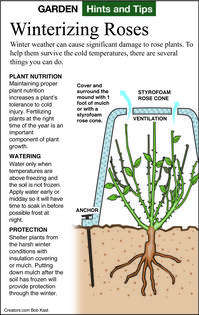The Greener View: Fall and Winter Rose Care
Q: How and when should rose bushes be pruned and winterized?
A: What kind of roses do you have? What kind of winter weather do you get?
Protecting roses is not too hard to do if you live in an area that does not freeze for many days in a row. The roses will slow down, lose some leaves and go dormant for a while on their own. Cut back spindly branches and any others that grow toward the middle of the plant. Cut them back to a bud that is pointing outward, so the new growth will not cross the center of the plant. Don't fertilize until it starts sending out new growth next spring.
In cold climates, many of the newer shrub roses, landscape roses, climbing roses, native roses and groundcover roses don't need much care. Just some pruning of weak branches and leaf cleanup in the fall will do until spring. In spring, clean up any dead or weak branches that didn't make it through the winter.
Roses in the grandiflora, floribunda, hybrid tea or tree rose categories are the ones that need some protection. The first thing to do is to give them good summer and fall care. Make sure they receive enough water in October and November. Roses may have to be watered a few times during this period, when many other plants won't need any. No fertilizer should have been applied after Labor Day.
Do not try to predict the upcoming winter's weather. It only takes a few bitterly cold days or a few days of drying winds to damage a plant in an otherwise mild winter. After a few frosts in the fall, it is time to cover these roses.
Remove any leaves still clinging to the plant and any on the ground under the plant. These leaves can house fungal spores that would infect the new leaves in the spring. In windy or really cold climates, spray the canes with an anti-desiccant from your local garden center. Mound up fresh soil from another part of the garden at least 6 inches to 1 foot high around the base of the plant. Be sure to cover the enlarged graft union area. Now cover and surround the soil mound with another foot of mulch or use a Styrofoam rose cone. Be sure to have a couple of holes in the top of the cone for ventilation, and be sure to anchor it down so it won't blow away.
Prune out any dead, damaged or diseased canes that stick out of the mound or would prevent putting on the cone. Leave as long a cane as possible over the winter. This gives as many buds as possible a chance to survive the winter.
In the spring, as the weather warms up, you can slowly remove the mulch and then the soil. At that time, you will decide which buds and stems to keep as next year's new growth. Most of the rose types that need winter protection bloom on the new season's growth, and so a heavy pruning in the early spring will not reduce next year's blooming. Again, prune to an outward-facing bud, so the new growth doesn't cross through the middle of the plant.
Climbing roses do bloom on the growth from the preceding year, so do very little fall pruning. Protect the canes if they are in a windy area by securely tying them to the trellis. They may need to be wrapped in burlap for additional protection. Prune climbing roses after they bloom in the spring.
========
Email questions to Jeff Rugg at info@greenerview.com. To find out more about Jeff Rugg and read features by other Creators Syndicate writers and cartoonists, visit the Creators Syndicate website at www.creators.com.
Copyright 2025 Jeff Rugg. Distributed By Creators.








Comments